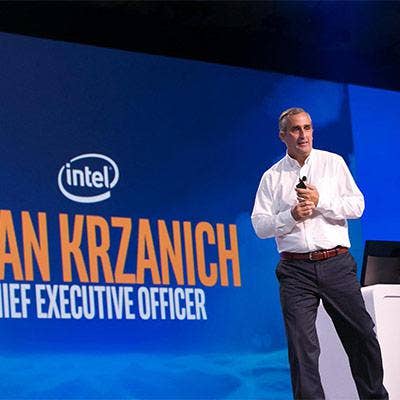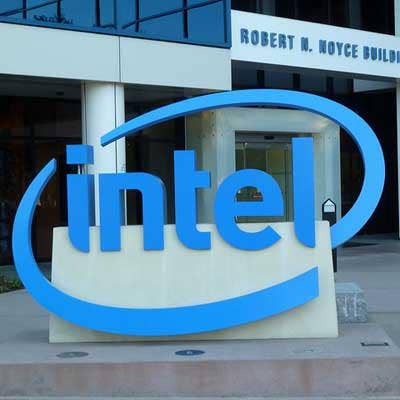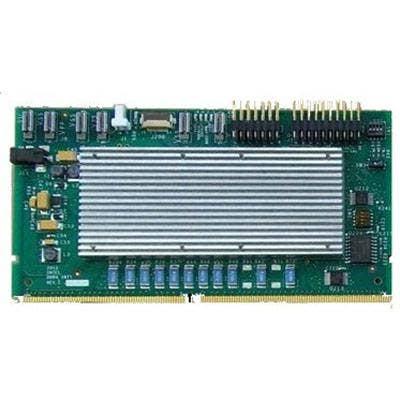Oracle OpenWorld 2015: Intel CEO Talks Transformational Partnership With Oracle

Intel Innovations Via OpenWorld
Oracle OpenWorld 2015 got going in earnest Sunday evening with a keynote from Intel CEO Brian Krzanich.
The two companies have partnered for decades and share 200,000 mutual customers, the chip maker's leader told thousands of Oracle partners gathered at the Moscone Center in San Francisco.
Together they are innovating across the enterprise data center during a period of tremendous transformation throughout the IT landscape. Those transformations will create opportunities for those who embrace them, as well as major new challenges to solve, Krzanich said.
As data centers become more complex, and the amount of data increases exponentially, Intel is seeking to optimize operations and make it easier to manage those tools, the CEO said.
Many of those investments are being made through the Cloud For All initiative, which set a goal in July of deploying tens of thousands of new clouds.

Four Initiatives
Intel's research and development efforts are being driven by four major initiatives within the company, Krzanich said.
-- Make it easy. That means encourage cloud technologies, and customer confidence in them.
-- Make it perform. Customers must see a performance advantage as they move to the cloud.
-- Make it compelling. Data systems must deliver actionable insights. Throwing data up isn't enough.
-- Make it secure. Security should be implemented across every application and for every enterprise. But security can't come at the cost of collaboration.
Those four initiatives guide Intel's hand as it develops the technologies that will power the Cloud of Tomorrow for both people and machines, Krzanich said.
To meet those goals, Intel is shepherding an ecosystem to help deploy software-defined infrastructure solutions that will standardize cloud deployments and allow the next wave of mission-critical enterprise apps to run in the cloud.

Project Apollo
Project Apollo is a scaled data center Intel has built somewhere in Oregon to run Oracle systems.
The facility was commissioned for testing and optimizing cloud software and platform architecture. Apollo launched months ago with the goal of being operational by OpenWorld. But Intel engineers finished ahead of schedule and started running VMs last month.
Doug Fisher, Intel's senior vice president of the software and services group, said the goal is to learn how to reduce complexity and fine-tune application performance in a complex cloud environment.
Apollo already has simultaneously spun up 1,500 virtual machines, measured workloads across them, and achieved 50 percent better performance and 10 times better predictability.
Apollo engineers will ultimately release for customers "blueprints" documenting knowledge gained from those tests about optimal architecture configurations and tuning.

Exa Your Power
This new program from Intel and Oracle is a broadside attack against an old foe.
Oracle CEO Mark Hurd (pictured) explained that a number of customers running Oracle software do it on "a product from a company called IBM" whose products are "large and costly."
"We think you can do better than this," Hurd said.
So Intel and Oracle launched the Exa Your Power program, which provides a free, customized proof-of-concept report for migrating from IBM Power systems to Oracle's Exadata servers powered by Intel processors.

3D XPoint Tech
Krzanich told OpenWorld attendees they will be shocked by the breakthroughs achieved with a new storage technology Intel has already developed. Those revolutionary solid-state devices are almost ready to hit the market.
The technology, called 3D XPoint, represents one of the most important storage advances of the past two decades, Krzanich said.
"The new chips will transform how we think about data and memory and storage," he said.
When compared to traditional Intel P37 SSDs, 3D XPoint delivers major improvements in IOPS and latency, speeding data access somewhere between five and eight times.
The chips will be available in 2016.

Next-Gen DIMMs
Volatile memory will see the same revolution as storage thanks to 3D XPoint, Intel's CEO said.
A new generation of DIMM memory chips is on its way that will perform like DRAM but offer the capacity and the cost of flash. The design of the next-generation DIMMs is based on the 3D XPoint technology.
"You can imagine a two-socket server running 6 Terabytes in memory, virtually eliminating paging before memory and storage, taking performance to a new level," Krzanich said.
The new DIMMs will transform how we view the separation between memory and storage, he said.

Streaming SQL
Big data usage varies greatly by industry and enterprise. Some companies are great at deriving insights from their data stores; others let all that valuable information just collect virtual dust.
But Intel wants to make it easy to build applications that mine and explore data, and it wants those insights to come in real time.
A new streaming SQL service based on the Spark big data framework will simplify and accelerate data analysis.
Intel wants to create a "playground for data scientists," Krzanich said.

TAP To Secure
The Trusted Analytics Platform (TAP) is an open-source Platform-as-a-Service for building and deploying secure big data applications.
The TAP tools and services Intel developed allow users to apply advanced analytic methods to sensitive or proprietary data sets without compromising the security of valuable information, Krzanich said.
TAP helps balance the dual imperatives of working with data and protecting that data.
It's one element of a larger end-to-end security story, Krzanich said.

Reliance Point
Because data is distributed, accessing it is often highly problematic, Krzanich said. That applies not only across geographies, but across owners.
Reliance Point, built from TAP technology, provides a protected virtual environment for sharing sensitive data, like medical records, without actually transferring the data.
The technology allows data scientists to collaborate in a secure shared environment, while always maintaining control over their proprietary data.